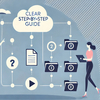
In human perception, there are many unwritten laws that function almost like mathematical rules. One of these laws concerns the perception of indirect information.
You may already know that information becomes more comprehensible when it is ‘wrapped’ in a story. You may have seen this law in action when explaining things to kids. Usually, it is not enough just to say ‘Don’t ride your bike without a helmet!’ This prohibition will be ignored (or argued against) simply because it is a sentence in the imperative mood.
But if you tell a kid a story about some other boy you knew who refused to wear a helmet because he was so sure of his riding skills, and how he once fell off his bike, got injured, and had to be taken to hospital – and you personally witnessed all of this, including the stitches on his forehead, his crying, and his promise to his mom to always wear his helmet – this story will be listened to for sure. You will be even asked questions about how many stitches there were on the guy’s forehead and how quickly he recovered…
You will be surprised by the genuine interest and empathy shown by your little listener. This phenomenon is intriguing and, as mentioned earlier, it operates like a mathematical rule. So, why not apply it to technical communication?
Instead of offering your customers a data sheet, a specification, or a manual (the direct ways of conveying information), try to engage them with a narrative. This blog will tell you about the advantages of scenario-based writing and the ways in which you can implement this writing technique in the development of your technical documentation.
The Power of Scenarios in Various Writing Contexts
Scenario-based writing mostly refers to fiction writing, as there can hardly be a work of fiction without a plot. There are the main characters, the rising and falling action, etc. A plot is like a motor that drives the machine of a novel.
What’s more, a plot keeps the audience involved. It makes the readers participate in the events emotionally. Another psychological aspect is that a plot makes the readers remember facts. It bestows coherence upon information. Without it, facts remain disjointed fragments of information and will never be retained.
A scenario-based approach can be applied to non-fiction as well. If users of your product have too many questions to the customer support, it means that your help documentation is too abstract, too complex, or overloaded with terminology. Scenario-based writing will help you implement the following three strategies that will make things easier for your audience:
- Presenting real-world examples. Instead of giving impersonal information through lists and tables, consider telling a story based on real-life experience. For example, instead of enumerating the features of your product, describe to your readers a day from the life of a tester in your company who tried to understand how these features work.
- Explaining complex concepts. Usually, complex notions, processes, etc. are NOT really explained. The explanation is usually presented as a puzzle, and the reader has to have a solid background to be able to understand the issue. Furthermore, not only are the concepts or processes inherently complex, but the language used in explanations is often saturated with terms and specialized jargon, leaving readers overwhelmed. Scenario-based writing allows you explain complex topics through storytelling. This is an indirect approach that empowers you to assume the role of a storyteller, stepping aside and allowing readers to uncover new and valuable insights.
- Facilitating information retention. As mentioned earlier, information tends to go unnoticed or elicits debate when presented in the form of directives. Paradoxically, however, retention improves when complex subject matter is expounded upon through the lens of a third person’s experience.
Summing up, scenario or story-based writing places the readers in realistic situations and helps them remember the information.

Crafting Effective Scenarios
There are a lot of tips on how to write an effective scenario, but they all come down to the following main guidelines:
- Identifying target audience and purpose. There’s nothing worse than the lack of focus on the audience. Think of your readers when writing scenario-based documentation. The audience analysis will allow you to ‘target’ your users – adopt their language, elucidate their daily routines, and delve into the work-related scenarios they routinely encounter. Your readers will undoubtedly value this approach.
- Ensuring realism and relevance. Readers will also notice any details that appear implausible. The best piece of advice here is to share the scenario with someone capable of assisting you in refining the specifics. Time and place will add realism to your writing. The context has to be perceived as authentic by the readers. To achieve realism, you will most probably have to do a research: try to find online accounts or blogs, or interview those who know the context from the inside.
- Setting clear objectives for scenarios. Always try to formulate your goals. If you are writing a series of scenario-based stories or blogs concerning the features of your product, the goal will be to teach the readers use these features. So, avoid introducing excessive distracting information and maintain a concise focus.
- Defining the desired emotional response. The best emotional response when explaining concepts (or instructing, as technical documentation is all about teaching after all) emerges when readers perceive that the credit for comprehending the information is theirs, not the author’s. Few things elicit greater satisfaction than personal achievement. Hence, a skilled instructor demonstrates rather than merely tells.
The list of the guidelines above is far from being complete. More recommendations can be added. However, the four above can serve as milestones in your writing endeavors.
Steps to Implement Scenario-Based Writing
To create effective scenario-based documentation, follow the steps below:
- Conduct thorough research. Your scenario won’t work if you are not familiar with the context. Conducting a research will help you look like an insider.
- Outline the structure of scenarios. When writing a scenario-based doc, think about ‘what follows what.’ Make the structure logical, otherwise, the users won’t come to the necessary conclusions.
- Seamlessly integrate scenarios into the narrative. Introducing a scenario into the narrative should not look deliberate. Make things natural.
- Incorporate dialogues and actions to enhance scenarios. Dialogues and actions will make the story look real. The people described will be trusted by the readers.
- Utilize descriptive language for engaging imagery. Make the language more diverse. Use similes and metaphors. They will help to distract readers and give them some rest. On the other hand, a good comparison can explain things better than a dozen of dictionary definitions.
The steps above will help you create effective documentation that will appeal to the reader.

Conclusion
The practice has shown that creating a collection of short stories that show how to use the features or procedures related to your product is far more effective than giving direct instructions on how to do it. Scenarios have proved to be a highly effective strategy for creating technical documentation. Scenario-based documents combine realistic environments and positive emotions. This makes a good background for retaining information. So if you want your users to grasp your message from the first glance or click, scenarios will be the right strategy for your team of technical writers.
Good luck with your technical writing!
ClickHelp Team
Author, host and deliver documentation across platforms and devices


